The Impact of Organisational Culture on an Organization’s Performance
VerifiedAdded on 2023/06/10
|8
|2459
|191
Essay
AI Summary
This essay discusses the significant impact of organizational culture on an organization's performance, emphasizing its role in employee motivation, productivity, and overall success. It highlights how a healthy organizational culture fosters employee engagement, improves brand image, and aids in talent acquisition. The essay also delves into Charles Handy's model of organizational culture, examining different types such as power, personal, task, and role cultures, and their respective effects. Examples from companies like Sainsbury's and Tesco illustrate how organizational culture influences operational activities, decision-making, and employee satisfaction. The conclusion underscores the importance of a strong organizational culture in achieving organizational goals and maintaining a competitive edge, with Desklib offering additional resources for students.
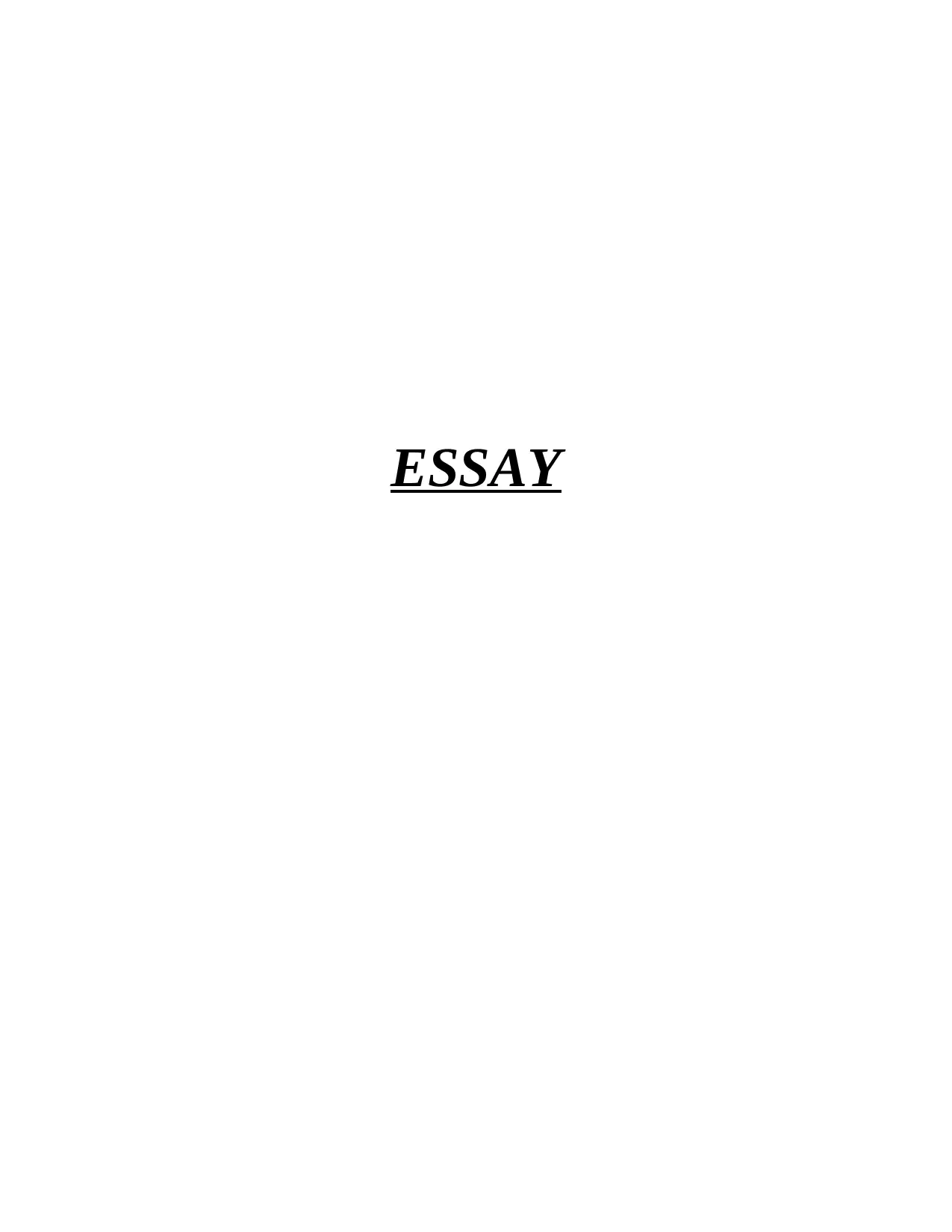
ESSAY
Paraphrase This Document
Need a fresh take? Get an instant paraphrase of this document with our AI Paraphraser

Table of Contents
INTRODUCTION...........................................................................................................................3
MAIN BODY...................................................................................................................................3
How does organisational culture impact on an organisation’s performance?.................................3
CONCLUSION................................................................................................................................7
REFERENCES................................................................................................................................1
INTRODUCTION...........................................................................................................................3
MAIN BODY...................................................................................................................................3
How does organisational culture impact on an organisation’s performance?.................................3
CONCLUSION................................................................................................................................7
REFERENCES................................................................................................................................1

INTRODUCTION
Organisation's success depend on their cultures that determines care of employees in the
organisation. It involves reward, value, recognition, feedback, language, behaviours,
communication, and beliefs that affect the company's business (He and Lee, 2020). The top level
managers support their employees in any situation because they have play a vital role in
company's objectives. The motivated employees fostering the company's efficiency as it help to
meet the organisation's goal. The report will cover the discussion about organisation's culture
along with its impact on organisation. In addition to this, theory of organisational culture as well
as examples of culture in company.
MAIN BODY
How does organisational culture impact on an organisation’s performance?
The culture defined as different ways of life for whole society such as values, beliefs and
norms . it refers to exchange the knowledge to other, make interaction with other, cognitive and
behaviours of society. It is a general patterns of entire social structure that followed by every
human beings. It play an important role in human developments as individual experience
different social culture in their life.
Organisation culture refers to unique culture in every organisation as it is difficult things
to change as it consists of unwritten rule and written rule which have been created over times.
The successful organisation require lots of time and effort for creating the healthy culture so that
it can be helpful for aligning the overall tasks It determine the general guideline to their staff to
follow the rules such as dress code, performance, communicate with colleagues, attitudes of
employees toward the tasks. The organisational culture is a omnipotent tool that impact on
employees in organisation and defined the atmosphere of the company . It is an important for
making healthy culture in company as it motivate the employees to increase the efficiency and
value of employees. The healthy culture of organisation help to provide direction to the staff to
perform effectively. The good organisational culture is help to maintain and improve the brand
image of company and improve the retaining the employees (Isensee and et al., 2020). The
culture is play crucial role in alluring the talent persons as candidates view the culture before
applying the job. The good culture in organisation support the staffs to take risk in difficult
time and render genuine feedback as if they are feel more comfortable and safe. It help to
Organisation's success depend on their cultures that determines care of employees in the
organisation. It involves reward, value, recognition, feedback, language, behaviours,
communication, and beliefs that affect the company's business (He and Lee, 2020). The top level
managers support their employees in any situation because they have play a vital role in
company's objectives. The motivated employees fostering the company's efficiency as it help to
meet the organisation's goal. The report will cover the discussion about organisation's culture
along with its impact on organisation. In addition to this, theory of organisational culture as well
as examples of culture in company.
MAIN BODY
How does organisational culture impact on an organisation’s performance?
The culture defined as different ways of life for whole society such as values, beliefs and
norms . it refers to exchange the knowledge to other, make interaction with other, cognitive and
behaviours of society. It is a general patterns of entire social structure that followed by every
human beings. It play an important role in human developments as individual experience
different social culture in their life.
Organisation culture refers to unique culture in every organisation as it is difficult things
to change as it consists of unwritten rule and written rule which have been created over times.
The successful organisation require lots of time and effort for creating the healthy culture so that
it can be helpful for aligning the overall tasks It determine the general guideline to their staff to
follow the rules such as dress code, performance, communicate with colleagues, attitudes of
employees toward the tasks. The organisational culture is a omnipotent tool that impact on
employees in organisation and defined the atmosphere of the company . It is an important for
making healthy culture in company as it motivate the employees to increase the efficiency and
value of employees. The healthy culture of organisation help to provide direction to the staff to
perform effectively. The good organisational culture is help to maintain and improve the brand
image of company and improve the retaining the employees (Isensee and et al., 2020). The
culture is play crucial role in alluring the talent persons as candidates view the culture before
applying the job. The good culture in organisation support the staffs to take risk in difficult
time and render genuine feedback as if they are feel more comfortable and safe. It help to
⊘ This is a preview!⊘
Do you want full access?
Subscribe today to unlock all pages.

Trusted by 1+ million students worldwide

organisation to follow equality as no one feel ignored or neglected in the tasks area as
employees treated well.
The organisational culture directly affect the business's operational activities such as
satisfaction, quality of work and engagement in work. If company not maintaining the healthy
culture among staffs that directly affect the performance of the company as unsatisfied
employees not perform well for organisation and it may increase the chance of resignation in the
company. If company provide reward and recognition to their employees as it increase the self
value to achieve the organisation's objectives. The strong organisational culture transform the
employee to advocates as it support the employees to maintain the comfortable culture. The
success of organisation directly depend on planning as good culture of organisation help to
communicate with other and determine the planing strategies (Mansouri, Singh and Khan,
2018). The strong organisational culture integrate the employees into teams as it increase the
value of teamwork and remove the conflict among employees. The healthy culture help in
appreciate the employees and eliminate stress so that employees more focus on their tasks. The
good management require instant decision strategy according to the requirements as
organisational culture help in support in difficulty time. The organisational culture determine
the good leadership strategy that help to eliminate the overlapping in work as leader direct
employees to perform the work in effective ways. However , The employee face difficulty, if
organisation has not strong organisational culture as they not freely communicate with senior as
it make frustrated in their job task. If organisation tolerate awful activities of employee as it
may give chance to other employees to behave the same way. The unpleasant culture may
incline the staff turnover reason being no one like to stick in this type of organisation and
company may face difficulty for alluring the new candidates. The competitive culture in
organisation lead to increase the politics and decline the knowledge sharing and spread the toxic
behaviour in the company so that it is for organisation to achieve the organisational objectives.
Inflexible culture in organisation lead to decrease the belief and value in employees to perform
for organisation goal and it hinder the company's progress (Sidani and Reese, 2018). The bad
organisational culture has not allowed to employee to perform in innovative ways and take
delayed action. The worst organisational culture lead to de-motivate the employee while doing
the task as it decrease the efficiency of the organisation. On the other hand, strong
employees treated well.
The organisational culture directly affect the business's operational activities such as
satisfaction, quality of work and engagement in work. If company not maintaining the healthy
culture among staffs that directly affect the performance of the company as unsatisfied
employees not perform well for organisation and it may increase the chance of resignation in the
company. If company provide reward and recognition to their employees as it increase the self
value to achieve the organisation's objectives. The strong organisational culture transform the
employee to advocates as it support the employees to maintain the comfortable culture. The
success of organisation directly depend on planning as good culture of organisation help to
communicate with other and determine the planing strategies (Mansouri, Singh and Khan,
2018). The strong organisational culture integrate the employees into teams as it increase the
value of teamwork and remove the conflict among employees. The healthy culture help in
appreciate the employees and eliminate stress so that employees more focus on their tasks. The
good management require instant decision strategy according to the requirements as
organisational culture help in support in difficulty time. The organisational culture determine
the good leadership strategy that help to eliminate the overlapping in work as leader direct
employees to perform the work in effective ways. However , The employee face difficulty, if
organisation has not strong organisational culture as they not freely communicate with senior as
it make frustrated in their job task. If organisation tolerate awful activities of employee as it
may give chance to other employees to behave the same way. The unpleasant culture may
incline the staff turnover reason being no one like to stick in this type of organisation and
company may face difficulty for alluring the new candidates. The competitive culture in
organisation lead to increase the politics and decline the knowledge sharing and spread the toxic
behaviour in the company so that it is for organisation to achieve the organisational objectives.
Inflexible culture in organisation lead to decrease the belief and value in employees to perform
for organisation goal and it hinder the company's progress (Sidani and Reese, 2018). The bad
organisational culture has not allowed to employee to perform in innovative ways and take
delayed action. The worst organisational culture lead to de-motivate the employee while doing
the task as it decrease the efficiency of the organisation. On the other hand, strong
Paraphrase This Document
Need a fresh take? Get an instant paraphrase of this document with our AI Paraphraser
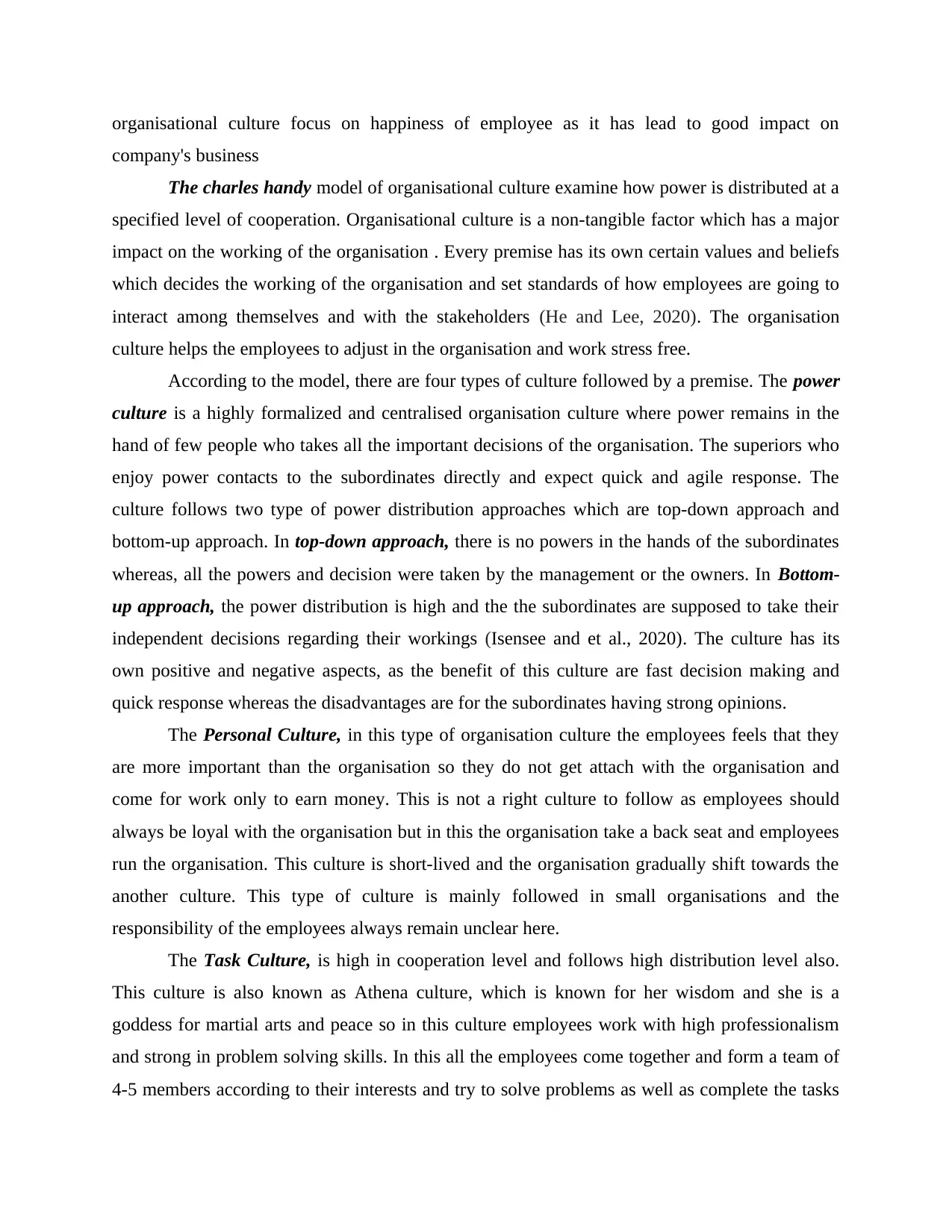
organisational culture focus on happiness of employee as it has lead to good impact on
company's business
The charles handy model of organisational culture examine how power is distributed at a
specified level of cooperation. Organisational culture is a non-tangible factor which has a major
impact on the working of the organisation . Every premise has its own certain values and beliefs
which decides the working of the organisation and set standards of how employees are going to
interact among themselves and with the stakeholders (He and Lee, 2020). The organisation
culture helps the employees to adjust in the organisation and work stress free.
According to the model, there are four types of culture followed by a premise. The power
culture is a highly formalized and centralised organisation culture where power remains in the
hand of few people who takes all the important decisions of the organisation. The superiors who
enjoy power contacts to the subordinates directly and expect quick and agile response. The
culture follows two type of power distribution approaches which are top-down approach and
bottom-up approach. In top-down approach, there is no powers in the hands of the subordinates
whereas, all the powers and decision were taken by the management or the owners. In Bottom-
up approach, the power distribution is high and the the subordinates are supposed to take their
independent decisions regarding their workings (Isensee and et al., 2020). The culture has its
own positive and negative aspects, as the benefit of this culture are fast decision making and
quick response whereas the disadvantages are for the subordinates having strong opinions.
The Personal Culture, in this type of organisation culture the employees feels that they
are more important than the organisation so they do not get attach with the organisation and
come for work only to earn money. This is not a right culture to follow as employees should
always be loyal with the organisation but in this the organisation take a back seat and employees
run the organisation. This culture is short-lived and the organisation gradually shift towards the
another culture. This type of culture is mainly followed in small organisations and the
responsibility of the employees always remain unclear here.
The Task Culture, is high in cooperation level and follows high distribution level also.
This culture is also known as Athena culture, which is known for her wisdom and she is a
goddess for martial arts and peace so in this culture employees work with high professionalism
and strong in problem solving skills. In this all the employees come together and form a team of
4-5 members according to their interests and try to solve problems as well as complete the tasks
company's business
The charles handy model of organisational culture examine how power is distributed at a
specified level of cooperation. Organisational culture is a non-tangible factor which has a major
impact on the working of the organisation . Every premise has its own certain values and beliefs
which decides the working of the organisation and set standards of how employees are going to
interact among themselves and with the stakeholders (He and Lee, 2020). The organisation
culture helps the employees to adjust in the organisation and work stress free.
According to the model, there are four types of culture followed by a premise. The power
culture is a highly formalized and centralised organisation culture where power remains in the
hand of few people who takes all the important decisions of the organisation. The superiors who
enjoy power contacts to the subordinates directly and expect quick and agile response. The
culture follows two type of power distribution approaches which are top-down approach and
bottom-up approach. In top-down approach, there is no powers in the hands of the subordinates
whereas, all the powers and decision were taken by the management or the owners. In Bottom-
up approach, the power distribution is high and the the subordinates are supposed to take their
independent decisions regarding their workings (Isensee and et al., 2020). The culture has its
own positive and negative aspects, as the benefit of this culture are fast decision making and
quick response whereas the disadvantages are for the subordinates having strong opinions.
The Personal Culture, in this type of organisation culture the employees feels that they
are more important than the organisation so they do not get attach with the organisation and
come for work only to earn money. This is not a right culture to follow as employees should
always be loyal with the organisation but in this the organisation take a back seat and employees
run the organisation. This culture is short-lived and the organisation gradually shift towards the
another culture. This type of culture is mainly followed in small organisations and the
responsibility of the employees always remain unclear here.
The Task Culture, is high in cooperation level and follows high distribution level also.
This culture is also known as Athena culture, which is known for her wisdom and she is a
goddess for martial arts and peace so in this culture employees work with high professionalism
and strong in problem solving skills. In this all the employees come together and form a team of
4-5 members according to their interests and try to solve problems as well as complete the tasks
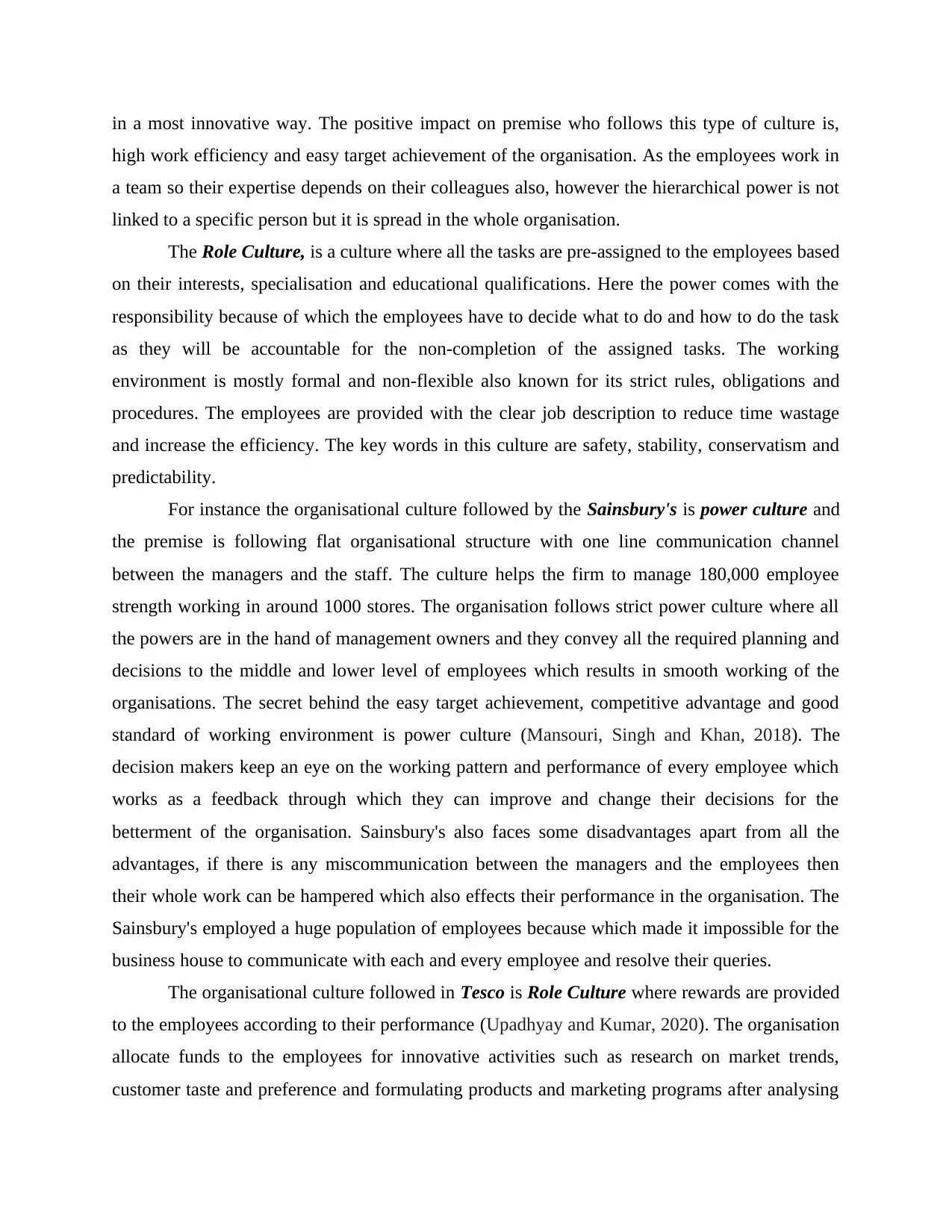
in a most innovative way. The positive impact on premise who follows this type of culture is,
high work efficiency and easy target achievement of the organisation. As the employees work in
a team so their expertise depends on their colleagues also, however the hierarchical power is not
linked to a specific person but it is spread in the whole organisation.
The Role Culture, is a culture where all the tasks are pre-assigned to the employees based
on their interests, specialisation and educational qualifications. Here the power comes with the
responsibility because of which the employees have to decide what to do and how to do the task
as they will be accountable for the non-completion of the assigned tasks. The working
environment is mostly formal and non-flexible also known for its strict rules, obligations and
procedures. The employees are provided with the clear job description to reduce time wastage
and increase the efficiency. The key words in this culture are safety, stability, conservatism and
predictability.
For instance the organisational culture followed by the Sainsbury's is power culture and
the premise is following flat organisational structure with one line communication channel
between the managers and the staff. The culture helps the firm to manage 180,000 employee
strength working in around 1000 stores. The organisation follows strict power culture where all
the powers are in the hand of management owners and they convey all the required planning and
decisions to the middle and lower level of employees which results in smooth working of the
organisations. The secret behind the easy target achievement, competitive advantage and good
standard of working environment is power culture (Mansouri, Singh and Khan, 2018). The
decision makers keep an eye on the working pattern and performance of every employee which
works as a feedback through which they can improve and change their decisions for the
betterment of the organisation. Sainsbury's also faces some disadvantages apart from all the
advantages, if there is any miscommunication between the managers and the employees then
their whole work can be hampered which also effects their performance in the organisation. The
Sainsbury's employed a huge population of employees because which made it impossible for the
business house to communicate with each and every employee and resolve their queries.
The organisational culture followed in Tesco is Role Culture where rewards are provided
to the employees according to their performance (Upadhyay and Kumar, 2020). The organisation
allocate funds to the employees for innovative activities such as research on market trends,
customer taste and preference and formulating products and marketing programs after analysing
high work efficiency and easy target achievement of the organisation. As the employees work in
a team so their expertise depends on their colleagues also, however the hierarchical power is not
linked to a specific person but it is spread in the whole organisation.
The Role Culture, is a culture where all the tasks are pre-assigned to the employees based
on their interests, specialisation and educational qualifications. Here the power comes with the
responsibility because of which the employees have to decide what to do and how to do the task
as they will be accountable for the non-completion of the assigned tasks. The working
environment is mostly formal and non-flexible also known for its strict rules, obligations and
procedures. The employees are provided with the clear job description to reduce time wastage
and increase the efficiency. The key words in this culture are safety, stability, conservatism and
predictability.
For instance the organisational culture followed by the Sainsbury's is power culture and
the premise is following flat organisational structure with one line communication channel
between the managers and the staff. The culture helps the firm to manage 180,000 employee
strength working in around 1000 stores. The organisation follows strict power culture where all
the powers are in the hand of management owners and they convey all the required planning and
decisions to the middle and lower level of employees which results in smooth working of the
organisations. The secret behind the easy target achievement, competitive advantage and good
standard of working environment is power culture (Mansouri, Singh and Khan, 2018). The
decision makers keep an eye on the working pattern and performance of every employee which
works as a feedback through which they can improve and change their decisions for the
betterment of the organisation. Sainsbury's also faces some disadvantages apart from all the
advantages, if there is any miscommunication between the managers and the employees then
their whole work can be hampered which also effects their performance in the organisation. The
Sainsbury's employed a huge population of employees because which made it impossible for the
business house to communicate with each and every employee and resolve their queries.
The organisational culture followed in Tesco is Role Culture where rewards are provided
to the employees according to their performance (Upadhyay and Kumar, 2020). The organisation
allocate funds to the employees for innovative activities such as research on market trends,
customer taste and preference and formulating products and marketing programs after analysing
⊘ This is a preview!⊘
Do you want full access?
Subscribe today to unlock all pages.

Trusted by 1+ million students worldwide
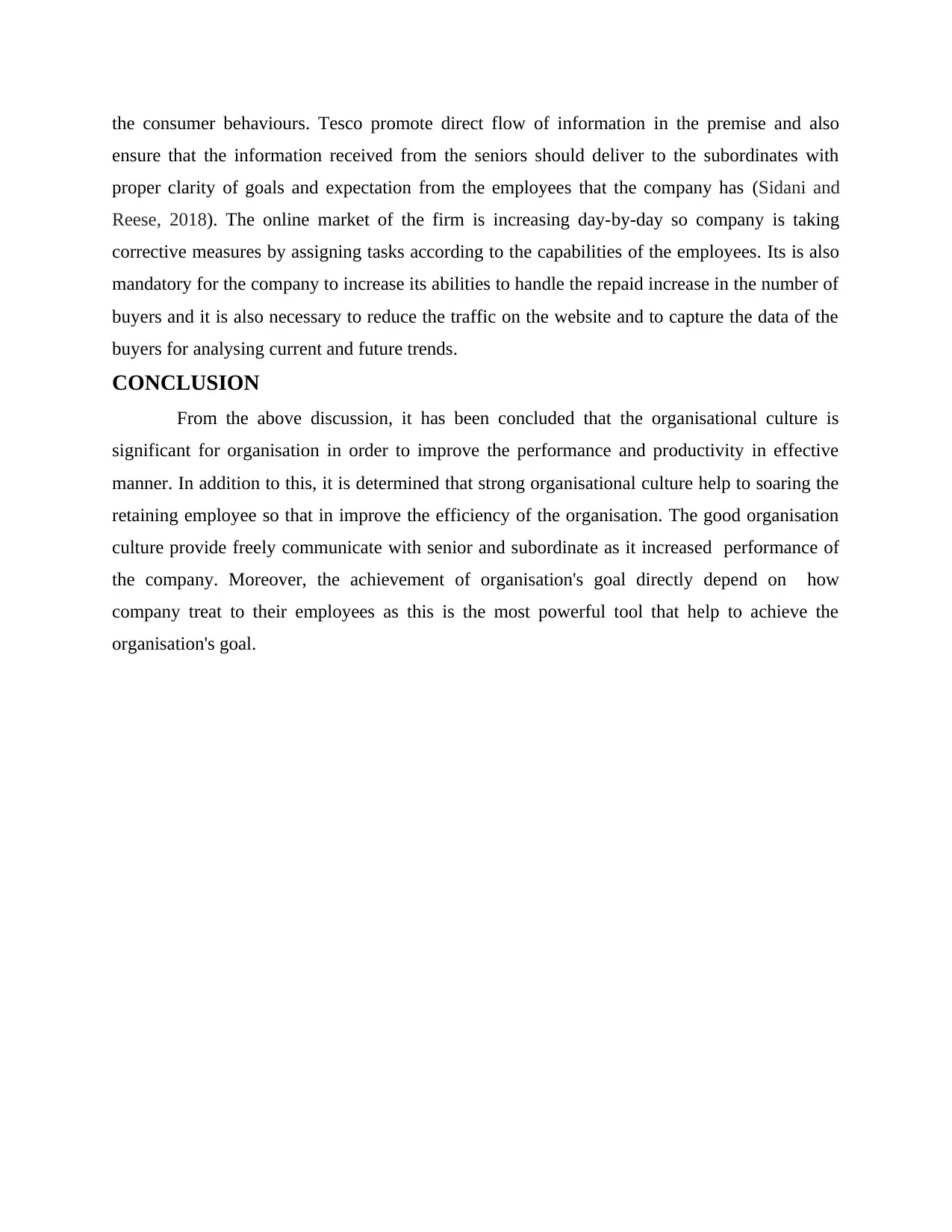
the consumer behaviours. Tesco promote direct flow of information in the premise and also
ensure that the information received from the seniors should deliver to the subordinates with
proper clarity of goals and expectation from the employees that the company has (Sidani and
Reese, 2018). The online market of the firm is increasing day-by-day so company is taking
corrective measures by assigning tasks according to the capabilities of the employees. Its is also
mandatory for the company to increase its abilities to handle the repaid increase in the number of
buyers and it is also necessary to reduce the traffic on the website and to capture the data of the
buyers for analysing current and future trends.
CONCLUSION
From the above discussion, it has been concluded that the organisational culture is
significant for organisation in order to improve the performance and productivity in effective
manner. In addition to this, it is determined that strong organisational culture help to soaring the
retaining employee so that in improve the efficiency of the organisation. The good organisation
culture provide freely communicate with senior and subordinate as it increased performance of
the company. Moreover, the achievement of organisation's goal directly depend on how
company treat to their employees as this is the most powerful tool that help to achieve the
organisation's goal.
ensure that the information received from the seniors should deliver to the subordinates with
proper clarity of goals and expectation from the employees that the company has (Sidani and
Reese, 2018). The online market of the firm is increasing day-by-day so company is taking
corrective measures by assigning tasks according to the capabilities of the employees. Its is also
mandatory for the company to increase its abilities to handle the repaid increase in the number of
buyers and it is also necessary to reduce the traffic on the website and to capture the data of the
buyers for analysing current and future trends.
CONCLUSION
From the above discussion, it has been concluded that the organisational culture is
significant for organisation in order to improve the performance and productivity in effective
manner. In addition to this, it is determined that strong organisational culture help to soaring the
retaining employee so that in improve the efficiency of the organisation. The good organisation
culture provide freely communicate with senior and subordinate as it increased performance of
the company. Moreover, the achievement of organisation's goal directly depend on how
company treat to their employees as this is the most powerful tool that help to achieve the
organisation's goal.
Paraphrase This Document
Need a fresh take? Get an instant paraphrase of this document with our AI Paraphraser
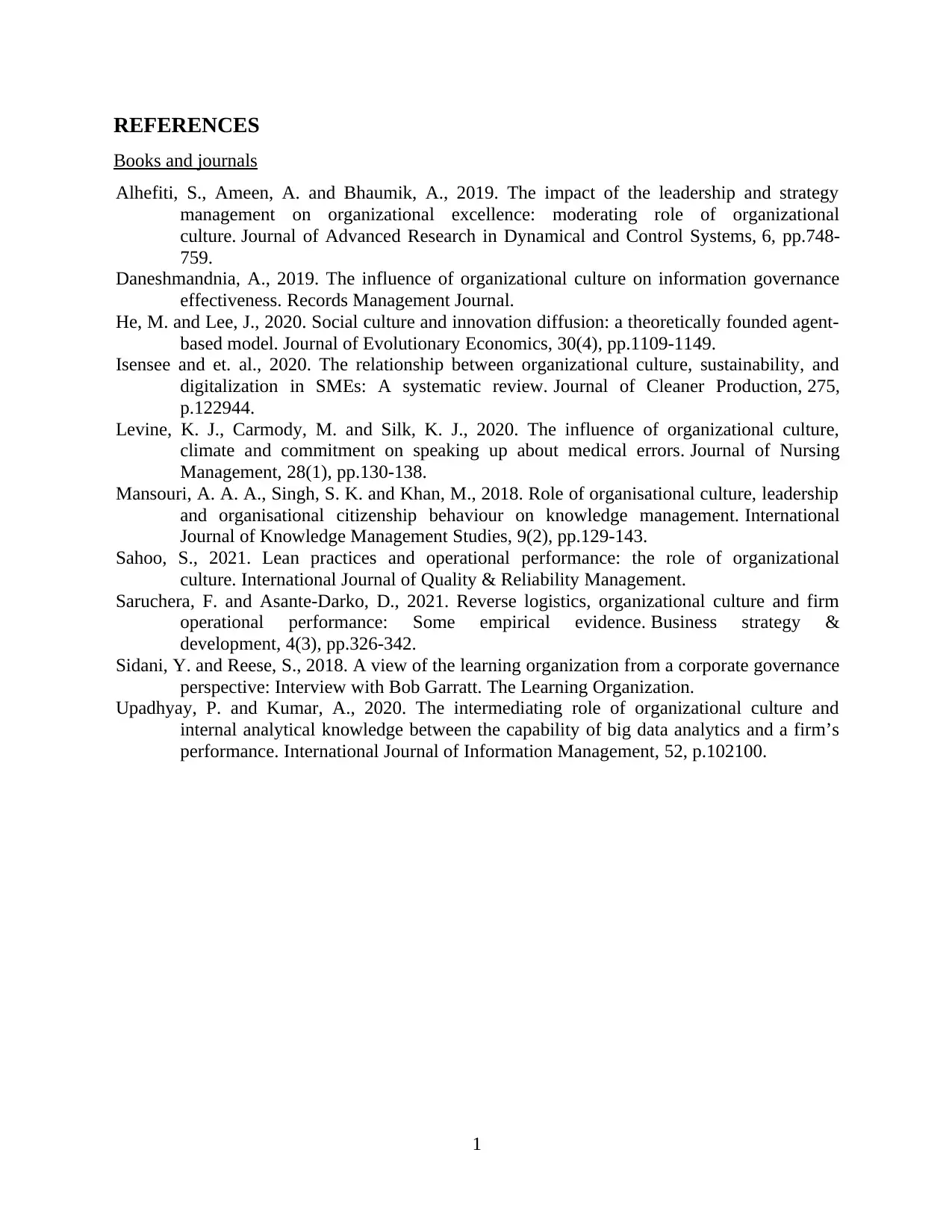
REFERENCES
Books and journals
Alhefiti, S., Ameen, A. and Bhaumik, A., 2019. The impact of the leadership and strategy
management on organizational excellence: moderating role of organizational
culture. Journal of Advanced Research in Dynamical and Control Systems, 6, pp.748-
759.
Daneshmandnia, A., 2019. The influence of organizational culture on information governance
effectiveness. Records Management Journal.
He, M. and Lee, J., 2020. Social culture and innovation diffusion: a theoretically founded agent-
based model. Journal of Evolutionary Economics, 30(4), pp.1109-1149.
Isensee and et. al., 2020. The relationship between organizational culture, sustainability, and
digitalization in SMEs: A systematic review. Journal of Cleaner Production, 275,
p.122944.
Levine, K. J., Carmody, M. and Silk, K. J., 2020. The influence of organizational culture,
climate and commitment on speaking up about medical errors. Journal of Nursing
Management, 28(1), pp.130-138.
Mansouri, A. A. A., Singh, S. K. and Khan, M., 2018. Role of organisational culture, leadership
and organisational citizenship behaviour on knowledge management. International
Journal of Knowledge Management Studies, 9(2), pp.129-143.
Sahoo, S., 2021. Lean practices and operational performance: the role of organizational
culture. International Journal of Quality & Reliability Management.
Saruchera, F. and Asante‐Darko, D., 2021. Reverse logistics, organizational culture and firm
operational performance: Some empirical evidence. Business strategy &
development, 4(3), pp.326-342.
Sidani, Y. and Reese, S., 2018. A view of the learning organization from a corporate governance
perspective: Interview with Bob Garratt. The Learning Organization.
Upadhyay, P. and Kumar, A., 2020. The intermediating role of organizational culture and
internal analytical knowledge between the capability of big data analytics and a firm’s
performance. International Journal of Information Management, 52, p.102100.
1
Books and journals
Alhefiti, S., Ameen, A. and Bhaumik, A., 2019. The impact of the leadership and strategy
management on organizational excellence: moderating role of organizational
culture. Journal of Advanced Research in Dynamical and Control Systems, 6, pp.748-
759.
Daneshmandnia, A., 2019. The influence of organizational culture on information governance
effectiveness. Records Management Journal.
He, M. and Lee, J., 2020. Social culture and innovation diffusion: a theoretically founded agent-
based model. Journal of Evolutionary Economics, 30(4), pp.1109-1149.
Isensee and et. al., 2020. The relationship between organizational culture, sustainability, and
digitalization in SMEs: A systematic review. Journal of Cleaner Production, 275,
p.122944.
Levine, K. J., Carmody, M. and Silk, K. J., 2020. The influence of organizational culture,
climate and commitment on speaking up about medical errors. Journal of Nursing
Management, 28(1), pp.130-138.
Mansouri, A. A. A., Singh, S. K. and Khan, M., 2018. Role of organisational culture, leadership
and organisational citizenship behaviour on knowledge management. International
Journal of Knowledge Management Studies, 9(2), pp.129-143.
Sahoo, S., 2021. Lean practices and operational performance: the role of organizational
culture. International Journal of Quality & Reliability Management.
Saruchera, F. and Asante‐Darko, D., 2021. Reverse logistics, organizational culture and firm
operational performance: Some empirical evidence. Business strategy &
development, 4(3), pp.326-342.
Sidani, Y. and Reese, S., 2018. A view of the learning organization from a corporate governance
perspective: Interview with Bob Garratt. The Learning Organization.
Upadhyay, P. and Kumar, A., 2020. The intermediating role of organizational culture and
internal analytical knowledge between the capability of big data analytics and a firm’s
performance. International Journal of Information Management, 52, p.102100.
1
1 out of 8
Related Documents
Your All-in-One AI-Powered Toolkit for Academic Success.
+13062052269
info@desklib.com
Available 24*7 on WhatsApp / Email
![[object Object]](/_next/static/media/star-bottom.7253800d.svg)
Unlock your academic potential
Copyright © 2020–2025 A2Z Services. All Rights Reserved. Developed and managed by ZUCOL.




